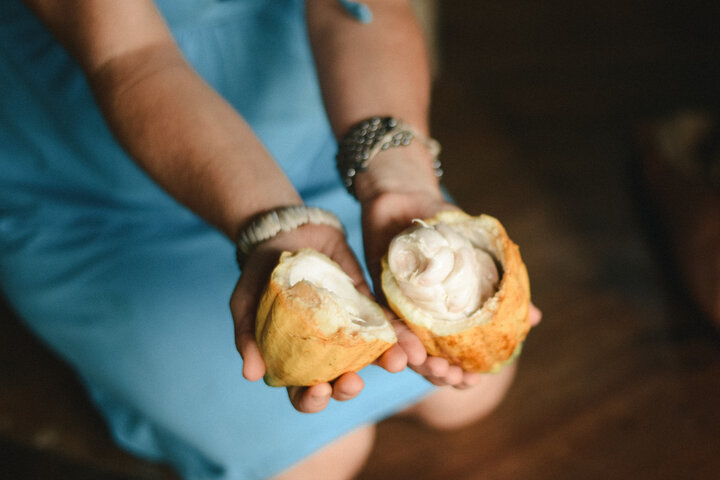When we drink ceremonial cacao, it’s easy to overlook the journey each bean takes before it reaches our cups. But behind every sip lies a profound dedication by cacao farmers who cultivate and process the cacao beans with care, tradition, and a deep connection to the land. Here, we’ll walk through a day in the life of a cacao farmer, exploring the intricate steps involved in the cacao farming process, from planting seeds to harvesting beans ready for ceremony.
Morning: Tending the Land and Checking the Cacao Trees
For cacao farmers, the day often begins at sunrise. Many farms are family-owned and passed down through generations, with farming techniques and traditions that have been carefully honed over centuries.
- Preparing the Soil and Trees: Organic cacao farming starts with rich, fertile soil that supports the growth of cacao trees without harmful pesticides. Farmers begin their day by inspecting the trees for any signs of disease or pests. The trees, which grow best in shaded, tropical environments, are nurtured with organic fertilizers and protected from direct sunlight.
- The Art of Pruning: Pruning is essential to cacao tree health, encouraging growth and preventing disease. Farmers delicately trim branches to allow sunlight to reach each tree’s base while ensuring enough shade remains to maintain an optimal microclimate.
A cacao farm’s morning routines set the foundation for healthy crops, reinforcing the farmers’ commitment to sustainable, organic practices that respect the land.
Late Morning: Hand-Pollinating Cacao Flowers
Cacao trees produce delicate flowers that bloom directly on the tree’s trunk and branches. These tiny blossoms must be pollinated to produce cacao pods, and because cacao has a low natural pollination rate, farmers often lend a helping hand.
- Hand-Pollination Techniques: Farmers use fine tools or brushes to gently pollinate flowers, increasing the chances of pod development. This labor-intensive process can involve pollinating hundreds of flowers in a single day, showcasing the dedication and attention to detail required in cacao farming.
- Working with Nature: Pollinators like midges are encouraged on cacao farms, where farmers preserve native plants and habitats to support the ecosystem. While these tiny insects assist in natural pollination, farmers supplement their work to ensure a higher yield.
This meticulous process highlights the intimate relationship cacao farmers maintain with their trees and the environment, working in harmony with nature to cultivate each bean.
Afternoon: Harvesting the Cacao Pods
By midday, it’s time for one of the most rewarding, yet labor-intensive tasks—harvesting the cacao pods. Each pod holds 30-40 cacao beans encased in a sweet, white pulp.
- Identifying Ripe Pods: Farmers walk through the groves, examining pods for ripeness. Cacao pods are ready to harvest when they turn from green to a vibrant yellow, red, or purple, depending on the variety. The farmer uses a machete or special pruning tool to carefully cut each ripe pod from the tree without damaging the trunk.
- Collecting and Sorting: Once harvested, the pods are gathered in large baskets. Farmers often sort through them to ensure only the best quality pods move on to the next stage. This careful selection impacts the flavor and quality of the final cacao product.
Harvesting cacao is a skill that requires patience and intuition, as each pod represents months of careful cultivation. Farmers take pride in selecting only the best pods, which are essential for producing high-quality ceremonial cacao.
Late Afternoon: Fermentation and Drying
Once the cacao pods are harvested, the beans need to go through a transformative process to develop their characteristic flavors. Fermentation and drying are two critical steps that influence the flavor profile of the cacao and ultimately, the quality of the final product.
- Fermentation: Farmers cut open the pods and scoop out the beans and pulp, placing them into wooden boxes or baskets. The beans are covered with banana leaves and left to ferment for up to seven days. During this time, natural yeasts and bacteria work to break down the sugars, creating the cacao’s unique flavor and aroma.
- Drying: After fermentation, the beans are spread out in the sun to dry. Farmers carefully turn them every few hours to ensure even drying, which can take up to a week. This drying process preserves the beans and prevents mold growth, making them ready for roasting.
Fermentation and drying require constant attention and expertise, as these stages are crucial for achieving the desired flavor profile. Skilled farmers know that the quality of their ceremonial cacao depends on the care taken during these steps.
Evening: Roasting and Grinding
For some cacao farmers, the process extends beyond drying. Many small farms roast and grind the cacao beans to create a ceremonial-grade paste, ready for ritual use.
- Roasting: The dried beans are lightly roasted to enhance their natural flavors. This step requires precision; over-roasting can ruin the flavor, while under-roasting may result in bitterness.
- Grinding: After roasting, the beans are ground into a thick, rich paste. This paste is the foundation for ceremonial cacao, with a smooth, intense flavor that connects drinkers to the bean’s natural essence.
With years of experience, farmers perfect the art of roasting and grinding, bringing the full richness of cacao to life for ceremonial use.
Reflecting on the Day: The Farmer’s Connection to Cacao
Each day, cacao farmers devote themselves to cultivating cacao with care, patience, and reverence for nature. Their work is a labor of love, often carried out by families and communities who have passed down these traditions for generations. From the delicate process of hand-pollination to the precision of roasting, every step in the cacao farming process impacts the final product’s quality and flavor.
- The Farmer’s Philosophy: For many farmers, cacao farming is more than a job; it’s a calling. Each pod, bean, and ceremonial drink connects people worldwide with the essence of cacao and the legacy of those who cultivate it.
- Supporting Sustainable Practices: By choosing ceremonial cacao from small-scale, organic farms, consumers can support these sustainable practices and honor the hard work and dedication of cacao farmers.
As we enjoy ceremonial cacao, it’s worth remembering the hands that have tended to each bean with love and care, making it possible for people worldwide to connect with cacao in their own rituals and ceremonies.
The next time you drink ceremonial cacao, take a moment to appreciate the journey that brought it to your cup. Behind each sip is the devotion of cacao farmers who embrace their work as a sacred responsibility. By honoring their traditions and supporting ethical cacao sources, we can share in the richness of cacao’s history and the dedication it takes to bring this superfood from seed to ceremony.

